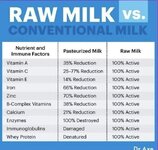200 years ago cows weren't being pumped with antibiotics and fed grains and expired candy, etc. And milk wasn't being sold through an industrial supply chain where its already a week old by the time you buy it. Sure if you know a local farmer with healthy grass fed cows who is willing to sell you fresh unpasteurized milk its probably fine, but in terms of mass produced milk being unpasteurized its a disaster waiting to happen.
Also its not true that Milk has only been pasteurized since 1862. I mean in a technical sense its true. But people have already been heating milk in pots over a fire for thousands of years which is effectively very similar to industrial pasteurization.
But ideally milk should be fermented for better digestion like how the mongols traditionally drank Ayrag, etc.
Also its silly to talk about lack of deaths from raw milk when so few people are drinking it. If everybody was drinking raw milk I can gaurantee you there would be a lot more deaths.
By the way raw milk is much healthier if done correctly but I am just saying realistically the whole dairy industry would have to make a lot of changes for raw milk to actually be both healthy and safe. Modern dairy farming doesn't operate in the same way as 200 years ago.
Below is an excerpt from this website:
http://www.pinkfarm.com.au/real-traditions/rawcultured-dairy/
"What is Pasteurisation? Loui Pasteur discovered pasteurisation in the late 1800’s. Milk was originally coming straight from the family cow or in glass jars from the local dairy. As US cities grew, urban dairies developed, and were often placed next to Whisky distilleries so the cows could be fed a cheap diet of ‘mash’ called ‘distillery slop’. These cows were confined, living in unhygienic conditions and being fed an unhealthy diet that was completely unsuited to their ruminant bodies and milk production. Disease was common and the milk was inferior, often unable to be used to make cheese or butter. Outbreaks of tuberculosis, infant diarrhea, scarlet fever and typhoid were on the rise and infant death rates from contaminated milk accounted for half of the infant deaths in NY in 1839.
Calls for pasteurisation were made as this meant killing pathogens that were carried in the milk. Initially raw milk was not blamed for illness and disease and a push for greater inspection laws of dairies was seen as the answer to decrease spread of disease. However, in 1914 a law was passed and pasteurised milk was the only milk that could be legally sold. Nina Planks sums this up beautifully stating, “ The trouble starts when you take a cow away from her natural habitat and healthy diet and force her to become a mere milk machine.”
It’s such a shame that mandatory inspections were not enforced to improve cow health and dairy hygiene but rather a quick fix of using pasteurisation to clean up for some lazy and unscrupulous farmers. Still today, some dairies have low health and hygiene standards, with farmers knowing that pasteurisation will ‘kill off’ any pathogens. Pasteurisation of milk does not only kill pathogens but this heating process also kills enzymes and immune factors, beneficial bacteria, decreases vitamin content and destroys B vitamins and denatures milk proteins. Not only is pasteurised milk a dead and lifeless product, pasteurisation is a huge reason why many people do not tolerate milk. They are often unable to digest the denatured protein (casein) and because beneficial enzymes have been killed off from the heating process, lactose is harder to break down."



